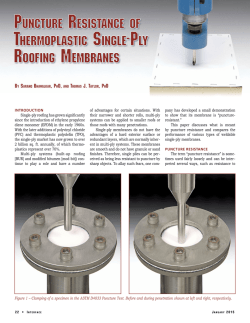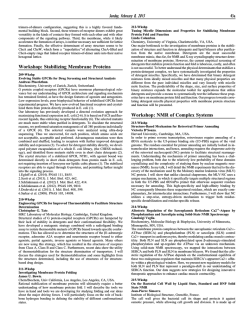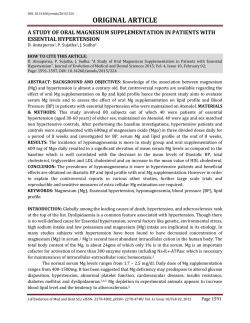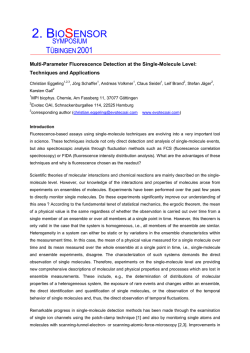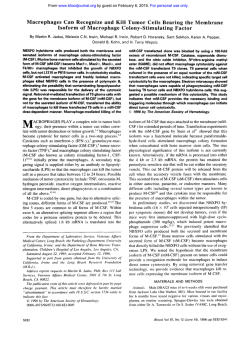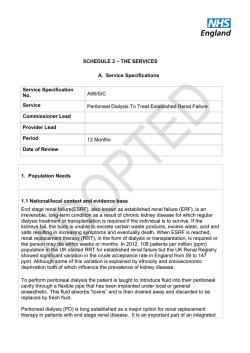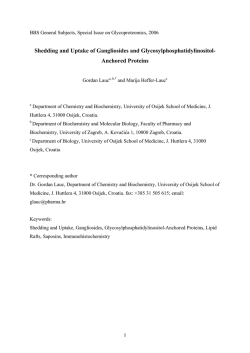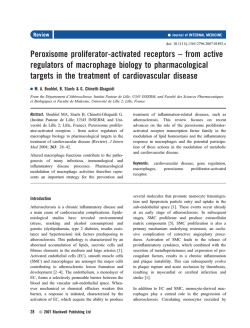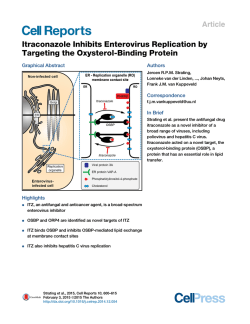
Age-dependent modification of lipid composition
mmam ELSEVIER SCIENTIFIC PUBLISHERS IRELAND Mechanisms of Ageing and Development 71 (1993) 1-12 Age-dependent modification of lipid composition and lipid structural order parameter of rat peritoneal macrophage membranes Eloisa Alvarez a, Valentina Ruiz-Guti6rrez b, Consuelo Santa Maria *a, Alberto Machado a aDepartamento de Bioquimica, Bromatologia y Toxicologia, Facultad de Farmacia, Universidad de Sevilla, Calle Prof. Garcia Gonz6lez s/n, 41012 Sevilla, Spain, blnstituto de la Grasa y sus Derivados, Avenida Padre Tejero 4, 41012 Sevilla, Spain (Received 8 October 1992; revision received 10 May 1993; accepted 25 May 1993) Abstract The effect of aging on the lipid composition and fluidity of rat peritoneal macrophage membranes has been determined using young (3 months), mature (12 months) and aged (24 months) Wistar rats. In the aged animals, total phospholipid decreased significantly (P < 0.05), whereas cholesterol increased (P < 0.01), with an age-dependent increase in the molar ratio of cholesterol/phospholipid. The most marked change in phospholipid content was the significant (P < 0. 001) age-dependent increase of phosphatidylserine and cardiolipin and the significant decrease of phosphatidylcholine and phosphatidylinositol. During aging there was a considerable decrease in arachidonic acid and docosapentanoic acid (about 50% in both cases). In contrast, an increase in the levels of oleic, linolenic and docosahexanoic acid was observed. Steady-state fluorescence polarization using 1,6-diphenyl-l,3,5-bexatriene as the probe was used to estimate the lipid structural order parameter of macrophage membranes. There was a highly significant (P < 0.001) age-dependent increase in the lipid structural order parameter, which correlated well with the increased molar ratio of cholesterol/ phospholipid in the membranes isolated from aged animals. The data suggests alteration in membrane lipid-protein interactions in aging, and are consistent with the hypothesis of the aging process. Key words: Lipid composition; Membrane fluidity; Macrophage; Aging * Corresponding author. 0047-6374/93/$06.00 © 1993 Elsevier Scientific Publishers Ireland Ltd. All rights reserved. SSDI 0047-6374(93)01365-F 2 E. Alvarez et al./Mech. Ageing Dev. 71 (1993) 1-12 1. Introduction Many investigations have suggested that age-dependent deterioration in cell functions can be related to molecular and functional changes in the properties of biological membranes [1-3]. The immune function is one of the systems that decrease with age [4-6], and alteration in membrane fluidity of lymphocytes has been closely associated with the decline in lymphocyte function during aging [7,8]. In addition to lymphocytes, macrophages play a critical role in the immune response. They appear to be involved in antigen presentation as well as in the secretion of factors that stimulate lymphocytes. Macrophages also have the capacity to kill microbes and tumor cells by generating reactive oxygen species when phagocytic stimuli or soluble agents interact with macrophage membrane, directly or through receptors [9-12]. The stimulus-membrane interaction activates a metabolic pathway called the respiratory burst. This is a co-ordinated series of metabolic events that leads to the production of oxygen-free radicals [13,14]. Taking into account the importance of membrane integrity in the phagocytic function of macrophages, the purpose of the present paper is to characterize the effect of aging on fluidity and lipid composition of peritoneal macrophage membranes in Wistar rats. Total phospholipid and cholesterol content and phospholipid and fatty acid composition were determined using young (3 months), mature (12 months) and old (24 months) rats. Fluorescence polarization with 1,6-diphenyl-l,3,5 hexatriene as the probe was used to evaluate the effect of aging on the lipid order parameter of peritoneal macrophage membranes. 2. Materials and methods 2.1. Animals Young (3 months), mature (12 months) and old (24 months) female Wistar rats were used. They were maintained on a standard laboratory diet with free access to food and water. 2.2. Chemicals Protease inhibitors were obtained from Sigma Chemical Company (St Louis, USA). 1,6-diphenyl-l,3,5-hexatriene was obtained from Fluka Chemie AG (Buchs, Switzerland). Fatty acid methyl ester standards (FAMES) were obtained from Larodan Fine Chemicals (Maim6, Sweden). The internal standard solutions were prepared by dissolving 200 mg of tricosanoic acid methyl ester (C23:0) in 100 ml of hexane. Calibration solutions were prepared by dissolving known amounts of FAME standards in hexane containing 2,6-ditertbutyl-p-cresol (butylated hydroxytoluene, BHT), obtained from Sigma. Other chemicals were of analytical grade from Merck (Darmstadt, Germany). 2.3. Preparation of peritoneal macrophages Peritoneal macrophages were elicited from Wistar rats according to the Tsunawsky and Nathan method [15]. Female Wistar rats, allowed free access to food and water, were injected intraperitoneally 4 days before harvest with 5 ml of 6% sodi- E. Alvarez et al./Mech. Ageing Dev. 71 (1993) 1-12 3 um caseinate. Animals were killed by decapitation, and immediately the peritoneal cavity was washed with 10 ml of saline solution. Cells were pelleted by centrifugation, resuspended in KRB and immediately used for experiments. Viability, determined by trypan-blue exclusion, was always greater than 95%. 2.4. Membrane isolation Macrophage membranes were obtained by the method described by Bromberg and Pick [16]. After the isolation of macrophages by the general method, the pellets were suspended in Hepes 5 mM, pH 7.5 with a cocktail of protease inhibitors. The peritoneal macrophages were incubated at 4°C for 15 min to provoke the hypoosmotic rupture of the cells. Samples of the cell suspension were sonicated at 4°C for 2 x 15 s. The cell rupture was evidenced by trypan-blue. Centrifugition was carried out at 1600 x g for 10 min to precipitate the unruptured cells. The supernatant was centrifuged at 30 000 x g for 30 min, and the resultant pellet was resuspended in Hepes 20 mM, pH 7.5 with phenyl-methyl-sulfonyl-fluoride (PMSF). 2.5. Extraction and separation o f lipids Quantitative extraction of total lipids from macrophage membranes was carried out following the method of Folch et al. [17] in the presence of BHT as antioxidant. Tissue dissociation was achieved by homogenization in ice-cold chloroformmethanol 2:1 (v/v) containing 0.01% BHT using an UltraTurrax model Type TP-18-1. The lipid extract was quantified gravimetrically and kept in a stoppered vessel under nitrogen atmosphere at -30°C until the assays. Lipid and phospholipid compositions were obtained by means of the Iatroscan TLC/FID technique [18,19]. The Iatroscan MK-5 was used in combination with Chromarods S, having a precoated active silica thin layer. Three #1 of total lipids or phospholipids was spotted on each rod, using a 10-#1 Hamilton syringe. To separate total lipids, rods were developed in hexane/diethyl ether/formic acid (90:10:2, v/v/v). The phospholipids were resolved in two steps, starting with an initial development of rods in chloroform/methanol/acetic acid/water (67:28:2:3, v/v/v/v), drying at 70°C for 10 min, and a second development in hexane/diethyl ether/formic acid (90:10:2, v/v/v). Rods were scanned under the following conditions: hydrogen flow, 150 ml/min; air flow, 1750 ml/min; scanning speed, 47 mm/s; chart speed, 42 mm/min. An Iatrocorder TC-11 integrator was used for recording and area integration. 2.6. Fatty acid analysis Fatty acids were analyzed by gas chromatogrphy (GC), as previously described [20-22]. The samples were saponified by heating for 5 min with 5 ml of 0.2 M sodium methylate and heated again at 80°C for 5 min with 6% (w/v) H2SO4 in anhydrous methanol. The fatty acid methyl esters thus formed were eluted with hexane and analyzed in a Hewlett-Packard 5890 series II gas chromatograph equipped with flame ionization detector and using an Omegawax 320 fused silica capillary column (30 m x 0.32 mm i.d., 0.25 /~m film). The initial column temperature was 200°C, which was held for 10 min, then programmed from 200-230°C at 2°C/min. 4 1£. Alvarez et al./Mech. Ageing Dev. 71 (1993) 1-12 The injection and detector temperatures were 250°C and 260°C, respectively. The flow rate of helium was 2 ml/min, the column head pressure was 250 kPa, and the detector auxiliary flow rate was 25 ml/min. Peak areas were calculated by a HewlettPackard 3990A recording integrator. Individual fatty acid methyl esters were identified on isothermal runs by comparison o f their retention time against those of standards. Fatty acid methyl esters were quantified by internal standardization (tricosanoic methyl ester, 23:0), using peak-area integration. Fatty acid methyl esters for which no standard was available were quantified using calibration tables of relative response ratios constructed according to carbon number (using gas chromatography-mass spectrometry, GC-MS). GC-MS was done on a Konik KNK2000 chromatograph interfaced directly to an AEJ MS30/70 VG mass spectrometer, using the electron impact mode. The ion source temperature was maintained at 200°C, multiplier voltage was 4.0 kV, emission current was 100 #A and electron energy was 70 eV. The data were processed with a VG 11/250 data system. 2. 7. Measurement of fluidity The steady-state fluorescence polarization and fluorescence anisotropy were determinated according to the method of Vorbeck et al. [23], utilizing the lipid-soluble fluorescent probe 1,6-diphenyl-l,3,5-hexatriene. Membranes were labeled at a protein concentration of 50-150 tzg/ml in a 1000fold dilution of 2 mM DPH stock solution (tetrahydrofuran as solvent) containing 0.25 M sucrose and 10 mM Tris-HCl pH 7,4 and incubated for 45 min. Measurements were made at 25°C and 37°C using a Perkin-Elmer 650-40 fluorescence spectrophotometer equipped with a polarizing filter. The excitation and emission wavelengths were 365 and 430 nm, respectively. The corrected steady-state fluorescence polarization (p) was calculated as p = (Ivv - Ivh / Iw + Ivh) where Ivv and Ivh are observed intensities measured with polarizers parallel to and perpendicular to, respectively, the vertically oriented polarizer exciting beam. The steady-state fluorescence anisotropy (rO was calculated from the ratio rs = 2p/(3-p) where p is the corrected fluorescence polarization. The limiting fluorescence polarization (roo) and the lipid structural order parameter (SDPr0 were calculated according to Pottel et al. [24]: ro, = 4/3 r s - 0.11 (where 0.13 < rs < 0.28) SDPH = (rMr0)l/2 (where roo/r0 = 4/3 rs/r0 - 0.28) Light scattering effects were non-detectable in our experimental conditions, since it was observed that dilutions of the samples from adult, mature and aged animals did not affect steady-state fluorescence polarization values. E. Alvarez et al./Mech. Ageing Dev. 71 (1993) 1-12 5 2.8. Statistical methods Student's test was utilized to evaluate differences between means, and the 0.05 level of probability was used as the criterion of significance. All values reported are means ± S.D. of at least five animals. 3. R ~ d ~ 3.1. Lipid composition The effect of age on phospholipid and free cholesterol content of peritoneal macrophage membranes is shown in Table 1. Although free cholesterol showed a significant age-related increase, it is clear that there was also a significant age-related decrease in phospholipid. The levels of cholesterol increased from a mean of 1.45% for young animals to a mean of 2.15% for the 24-month-old animals. In contrast, the content of phospholipids decreased from a mean of 98.62% for young animals to a mean of 97.84% for those of 24 months. In the mature animals the levels found were intermediate between young and old animals. No differences were found with respect to those of 3 months; however, in both cases (free cholesterol and phospholipids) the differences versus 24-month-old animals were significant (P < O.O1). The inverse relationship between the change in phospholipid and free cholesterol content and age results in an increase in the molar ratio of cholesterol/phospholipid. To determine whether the phospholipid composition of macrophage membrane was altered with age, the major phospholipid species were quantified by means of the Iatroscan TLC/FID technique. The results of these analyses are given in Table 2. Several phospholipids increased with age. The most marked change was the significant increase (approximately 3-fold) of lisophosphatidylcholine in the 24-monthold animals. (The levels in 3- and 12-month-old animals were similar.) The age increase in phosphatidylserine and cardiolipin (approximately 102%) was observed in 12 and 24-month-old animals. A progressive age increase was observed in the sphingomyelin content. In contrast, a significant decrease was found in the phosphatidylcholine and phosphatidylinositol content in 12 and 24-month-old animals. Although phosphatidylethanolamine (the other major phospholipid) also decreased, the difference was not statistically significant. Table 1 Effect of age on lipid composition of peritoneal macrophage membranes Age (months) 3 12 24 Percentage (w/w) Free cholesterol phospholipids Ratio of cholesterol/ Phospholipids 1.45 ± 0.127 1.73 ± 0.042 2.15 ± 0.021 a'b 98.62 ± 0.262 98.01 ± 0.013 97.84 ± 0.014 a'b 0.015 0.018 0.022 The values represent the mean ± S.D. from at least five separate experiments. Statistical significance: ap < 0.05 versus 3 months; bp < 0.01 versus 12 months. 6 E. AIvarez et al./Mech. Ageing Dev. 71 (1993) 1-12 Table 2 Effect of age on major phospholipid content of peritoneal macrophage membranes Phospholipids PS + CL PI PE PC SM LPC Percentage (w/w) 3 months 12 months 24 months 12.54 6.16 27.47 48.15 3.48 2,13 25.76 4.29 26.63 37.14 5.05 2.15 25.37 3.82 22.17 33.39 7.86 6.77 444q44- 3.11 0.19 3.21 8.14 1.14 0.21 44+ 4:t: 4- 2.98 a 0.09 a 4.05 2.25 a 0.52 a 1.44 ± 2.72 c ± 0.11 c 4- 4.73 ± 3.72 c -4- 0.38 b.c 4- 2.32 b,c The values represent the mean q- S.D. from at least five separate experiments. PS: phosphatidylserine; CL: cardiolipin; Ph phosphatidylinositol; PE: phosphatidylethanolamine; PC: phosphatidylcholine; SM: sphingomyelin; LPC: lisophosphatidylcholine. Statistical significance: ap < 0.01 versus 3 months; bp < 0.01 versus 12 months; cp < 0,01 versus 3 months. 3.2. Fatty acid content A comparative analysis of fatty acid levels was made on peritoneal macrophage membranes from rats of different ages (3, 12 and 24 months). The results obtained are given in Table 3. Palmitic acid (16:0) was the predominant fatty acid found in peritoneal macrophage membranes in each of the age groups examined (between 22 and 24% of the total fatty acids). Lauric acid (12:0) comprised the smallest part (between 0.3 and 0.5%) of the total fatty acids. During aging there was an appreciable and progressive decrease in arachidonic acid (20:4) (from approximately 12% in young, to 9% in mature and 6% in aged animals). A decrease in the levels of docosapentaenoic (22:5), docosatetraenoic (22:4) and tetracosenoic (24:1) acid was also apparent during aging. The decrease in the 24:1 and 24:4 was significant even in rats of 12 months. In contrast, we observed an ifmrease in the levels of oleic (18:1), linolenic (18:3) and docosahexanoic (22:6) acid during aging (the levels in 12-month-old rats were similar to those in 3-month-old rats). The levels of the other fatty acids changed relatively little between the ages studied. One important change found in this study was the increase of total (n-3) fatty acids (mainly 22:6) accompanied by a decrease in total (n-6) fatty acids (mainly 20:4) in the aged animals. As a consequence, there was a reduction in the ratio (n-6)/(n-3) in these animals. 3.3. Membrane fluidity The steady-state fluorescence polarization and fluorescence anisotropy data for DPH-labeled macrophage membrane preparations from young, mature and aged animals are given in Table 4. There was a highly significant (P < 0.001) increase in fluorescence polarization between 25°C and 37°C. Fluorescence anisotropy also increased in preparations from the 24-month-old animals (P < 0.001). In mature animals the levels observed were intermediate (and statistically significant) between 3 and 24 months. E. Alvarez et al./Mech. Ageing Dev. 71 (1993) 1-12 Table 3 Effect of age on major fatty acid composition of peritoneal macrophage membranes Fatty acids C12:0 C14:0 Cl4:l,n. 7 C16:0 Ci6:l,n. 7 C16:4,n.3 Cl8:0 Ci8:l,n. 9 Cis:l,n. 7 Ci8:2,n.6 C18:3,n.3 C20:4,n.6 C22:4,n.6 C22:5,n.6 C22:6,n.3 C24:1 C24:1 Saturated Monoenoic Polienoic Total n-6 Total n-3 n-6/n-3 Monoenoic/ saturated C2o:4/Ci8:2 Percentage (w/w) 3 months 12 months 24 months 0.315 2.570 1.460 22.600 6.220 3,500 13.415 13.950 2.505 4.975 3.075 12.200 0.700 3.915 5.670 1.590 1,290 40.490 25.420 34.030 21.790 12.240 1.780 0.627 0.392 3.125 1.430 23.902 6.767 3.076 12.836 14.265 3.065 5.840 2.935 9.420 0.575 3.935 5.810 2.020 0.515 42.275 26.042 31.591 19.770 11.821 1.672 0.616 0.410 2.995 1.420 22.435 6.815 2.760 12.515 17.420 3.165 5.970 6.060 6.290 0.570 2.075 8.620 1.340 0.510 39.690 29.690 32,340 14.900 17.440 0.850 0.748 2.450 4- 0.035 4. 0.269 4- 0.014 q- 0.948 ± 0.042 4- 0.290 4- 0.587 :t: 0.580 ± 0.007 4- 0.247 ± 0.304 q- 0.255 4- 0.028 4- 0.120 q- 0.382 4- 0.580 4. 0.099 4- 2.419 q- 0.742 4- 1.626 4- 0.650 4- 0.979 1.613 4- 0.039 4. 0.150 4- 0.315 4. 0.824 4- 0.450 4- 0.178 q- 0.405 q- 0.460 4- 0.245 ± 0.825 4. 0.276 4- 0.141 a 4- 0.014 a ± 0.148 4- 0.141 q- 0.245 4. 0.021 a 4- 2.013 4- 1.425 4- 2.592 4- 0.521 4- 1.051 ± 0.057 ± 0.016 4- 0,350 4- 1.082 + 0.926 4- 0.010 4- 0.040 4- 0.550 b'¢ 4- 0.658 4- 1.245 4. 0.085 b'c 4- 0.495 b'c 4- 0,028 c 4- 0.092 b'c 4- 0.962 b'c 4. 0.042 4. 0.010 c 4- 1.237 4- 2.485 4- 4.152 4- 2.072 b'c 4- 2.080 b'c 1.053 The values represent the mean 4- S.D. from at least five separate experiments. The sum of the saturated, monoenoic and polyenoic (poli.) was calculated for all positively identified fatty acids. Statistical significance: ap < 0.05 versus 3 months; bp < 0.05 versus 12 months', cp < 0.05 versus 3 months. Pottel et al. [24] have presented an empirical relationship between steady-state fluorescence anisotropy and the limiting fluorescence anisotropy. From this relationship they estimated a lipid structural order parameter (reciprocal of fluidity) directly from simple steady-state fluorescence polarization measurements of a variety of membranes. Using the same relationship, we estimated the lipid structural order parameter in macrophage preparations. As shown in Table 4, there was a significant increase in the lipid order parameter in macrophage membranes from the 12 and 24month animals at the two temperatures studied. 4. Discussion Results from the present study show that peritoneal macrophage membranes isolated from young, mature and aged rats differ considerably in both lipid content and fluidity. 8 E. Alvarez et al./Mech. Ageing Dev. 71 (1993) 1-12 Table 4 Steady-state fluorescence polarization, steady-state fluorescence anisotropy and lipid order parameter of peritoneal macrophage membranes. Age 3 months 12 m o n t h s 24 months (25°C) 0.282 + 0.003 0.290 + 0.005 a 0.299 + 0.008 b'c (37°C) 0.220 4- 0.006 0.230 4- 0.002 a 0.234 + 0.003 b'c (25°C) 0.207 + 0.003 0.213 + 0.005 a 0.222 + 0.006 b.c (37°C) 0.158 + 0 . 0 0 4 0.166 q- 0.002 a 0.169 4- 0.002 b.c (25°C) 0.165 4- 0.004 0.174 4- 0.006 a 0.185 4- 0.007 b'c (37°C) 0.102 4- 0.006 0.111 + 0.003a 0.115 4- 0.003 b.c (25°C) 0.638 4- 0.007 0.656 4- 0.012 a 0.676 + 0.014 b'c (37°C) 0.495 4- 0.015 0.522 4- 0.007 a 0.531 4- 0.008 b'c PDPH 1 rs2 ro~3 SDPH 4 1. Fluorescence polarization (PDPH) = (|vv - lvh)/(Ivv + Ivh)' 2. Fluorescenceanisotropy (rs) = 2P/(3 - P). 3. Limiting fluorescence anisotropy (r®) = 4/3 r s - 0.11 ( w h e r e 0.13 < rs < 0.28). 4. Lipid order parameter (SDPH) = (r~./r0)~/2; (ro./r 0 = 4/3 r J r 0 - 0.28) (where ro = 0.4). The values represent the mean q- S.D. from at least five separate experiments. Statistical significance: a p < 0.005 versus 3 m o n t h s ; b p < 0.05 versus 12 m o n t h s ; c p < 0.001 versus 3 months. An age-related increase in free cholesterol has been found, together with a decrease in the phospholipid content (Table 1). These changes lead to an increment in the molar ratio of cholesterol/phospholipid with age. Similar results have been described in other membranes from aged animals [11. The increase in the molar ratio of cholesterol/phospholipid observed in peritoneal macrophage membranes isolated from aged animals is consistent with the increase in the lipid order parameter (reciprocal of fluidity) that we have described (Table 4). The molar ratio of cholesterol/phospholipid is considered to be a main determinant of lipid fluidity of both artificial and biological membranes [25]. Various investigations have suggested that aging might be accompanied by a reduction in membrane fluidity. An increment in membrane microviscosity as a result of aging has been demonstrated in human platelets [26], rat intestinal microvilli [27], mice lymphocytes [28], human erythrocytes [29] and rat brain [301. The physiological implications of the observed increase in the lipid order parameter with age may relate primarily to modulation of the dynamics of membrane proteins. In erythrocyte membranes, changes in membrane cholesterol content and lipid fluidity have been shown to alter the availability of protein sulfydryl groups at the surface of the membrane [31,32]. In liver mitochondria, the consequences of in vivo E. Alvarez et al./Mech. Ageing Dev. 71 (1993) 1-12 9 or in vitro manipulation of cholesterol content have been correlated with changes in membrane function [33]. In macrophages, the degree of lipid fluidity influenced both phagocytosis and pinocytosis [34]. To check whether phospholipid composition changed with age, the major phospholipid species were quantified. The phospholipid content for the control group was similar to that described by Brouard and Pascaud [35]. The predominant phospholipids in adult animals were ethanolamine and phosphatidylcholine. These were also the major phospholipids extracted from macrophage membranes of adult rabbit [36]. The levels of phosphatidylcholine and phosphatidylinositol declined with age, whereas sphingomyelin, lisophosphatidylcholine, phosphatidylserine and cardiolipin increased with age (except in lisophosphatidylcholine, all the changes were significant in mature animals). The increase in the relative amount of sphingomyelin is, together with the increment in the cholesterol/phospholipid ratio, another important cause of the rise in membrane microviscosity [37]. At the same time, the decrease in phosphatidylinositol is particularly relevant, because many stimuli act through hydrolysis of phosphatidylinositol to activate NADPH oxidase, the enzyme responsible for the respiratory burst [9] and which seems to decrease with age [unpublished results]. It has been stated that aging can alter the fatty acid composition and that this change may alter the membrane fluidity [38]. We have studied the fatty acid composition of macrophage membranes and our analysis revealed the presence of four major fatty acids in young animals: palmitic (16:0), stearic (18:0), oleic (18:1) and arachidonic (20:4), as has also been described for young mouse peritoneal macrophages [39]. However, in aged animals the arachidonic acid decreased to approximately 50% and the fourth major fatty acid was docosahexaenoic (22:6). Arachidonic acid (20:4) may act as a potent stimulator of superoxide anions, which might influence cellular functions at a later stage [40].. In addition, arachidonic acid is the precursor for prostaglandins, leukotrienes and hydroxy fatty acids which have feedback influence on the functions of phagocytic cells [41,42]. Since arachidonic acid (20:4) may act as a stimulant of superoxide anions, the great decrease that we have observed in arachidonic acid may bg related to the decrease in the production of superoxide anions that we have found in aged animals [unpublished data] and affect the phagocytic function of these cells. The decline in arachidonic acid (20:4) is not accompanied by a similar fall in linoleic acid (18:2) in the aged animal; thus there is a reduction in the ratio 20:4/18:2 with age. In other tissues this reduction has been attributed to a reduction in the desaturation of essential fatty acids produced by an inhibition of the enzyme A6 desaturase [43]. In many mammalian tissues, 18:2 (n-6) is converted to 20:4 (n-6) by an alternating sequence of A6 desaturase, chain elongation and A5 desaturation. It has been demonstrated that murine peritoneal macrophages lack A6 desaturase activity [44], have substantial elongase activity [44], and possess a slight A5 desaturase activity [45]. The lack of A6 desaturase in murine macrophages suggests that the availability of macrophage 20:4 (n-6) cannot be modulated at the level of local synthesis from 18:2 (n-6) - - its major dietary essential fatty acid antecedent - - and that the difference between young, mature and aged levels must be due to other causes. On the other hand, the decrease in arachidonic acid might be related to a greater 10 E. Alvarez et al./Meeh. Ageing Dev. 71 (1993) 1-12 peroxidation of polyunsaturated lipids, which has been reported to increment with age [46] because of a greater production in free radicals or lower protection [47-50]. This might be responsible for the great incidence of atherosclerosis with age. Most of the foam cells are derived from monocyte-macrophages [51 ]. These macrophages accumulate lipids in their cytoplasm, most of which consists of low-density lipoprotein (LDL). However, the L D L must be modified before it will produce cholesterol ester accumulation. The reaction with malondialdehyde and acetylation are the most important modifications [52,53]. Docosahexaenoic acid (22:6) increased with age and was the fourth major fatty acid in the 24-month animals. Docosahexaenoic acid is a strong inhibitor of cyciooxygenase [54] and has been shown to inhibit leukotriene synthesis in mouse peritoneal macrophages [35]. Another important change described in our study was the increase of total (n-3) fatty acids (mainly 22:6) accompanied by a decrease in total (n-6) fatty acids (mainly 20:4) with age. As a consequence, there is a reduction in the ratio (n-6)/(n-3) in the aged animals. Earlier reports have demonstrated that (n-3) fatty acids inhibit the metabolism of (n-6) fatty acids. Thus the reduction in the ratio (n-6)/(n-3) in aged animals might be due to an inhibition of the metabolism of (n-6) fatty acids produced by (n-3) fatty acids. The balance between (n-6) and (n-3) fatty acids plays an important role in the regulation of the physicochemical nature of the membrane lipid matrix, which in turn might influence the function of a wide variety of intrinsic and extrinsic membrane-bound enzymes [55]. This may also contribute to altering the macrophage membrane function with age. 5. Acknowledgement Eloisa Alvarez is a recipient of a fellowship from the Junta de Andalucia. This work was supported by grant PB89-0173 from CAI de Ciencia y Tecnologia. 6. References 1 L.S. Grinna, Changes in cell membranes during aging. Gerontol., 23 (1977) 452-464. 2 I. Zs-Nagy,The role of membrane structure and function in cellular aging: a review. Mech. Ageing Dev,, 9 (1979) 237-246. 3 F. Schroeder, Role of membrane lipid asymmetry in aging. Neurobiol. Aging, 4 (1984) 323-333. 4 R.A. Miller, Aging and the immune response. In E.L. Schneider and J. W. Rowe (eds.), Handbook of the Biology of Aging (third edition), Academic Press, New York, 1990, pp. 157-180. 5 M.E.Wekslerand G.W. Siskind, The Cellular Basis oflmmune Senescence (Monogr. Dev. Biol., vol. 17), Kargel, Basel, 1984, pp. 110-121. 6 E.A. Goild, Aging and the Immune Response, Marcel Dekker, New York, 1987. 7 R.E. Callard, A. Basten and R.B. Blanden, Loss of immune competencewith age: a qualitative abnormality in lymphocytemembranes. Nature. 281 (1979) 218-220. 8 J. Venkatramanand G. Fernandes, Modulation of age-related alterations in membranecomposition and receptor-associatedimmune function by food restriction in Fischer 344 rats. Mech. Ageing Dev., 63 (1992) 27-44. 9 F. Rossi, The O2-formingNADPH oxidase of the phagocytes: nature, mechanismof activation and function. Biochim. Biophys. Acta, 855 (1986) 65-89. 10 F. Morel, J. Doussiere and P.V. Vignais, The superoxide-generating oxidase of phagocytic cells: physiological, molecular and pathological aspects. Eur. J. Biochem., 201 (1991) 523-546. E. Alvarez et al./Mech. Ageing Dev. 71 (1993) 1-12 11 11 A.J. Ibarra and R.R. Strauss, The Respiratory Burst and its Physiological Significance, Plenum, New York, 1988. 12 M.D. Chiara, F. Bedoya and F. Sobrino, Cyclosporine A inhibits phorbol ester-induced activation of superoxide production in resident mouse peritoneal macrophages. Biochem. J., 264 (1989) 21-26. 13 B.M. Babior, Oxygen-dependent microbial killing by phagocytes. N. Engl. Med., 298 (1978) 659-668. 14 B. Halliwell and J.M.C. Gutteridge, Free radicals in biology and medicine, Clarendon Press, Oxford, 1989. 15 S. Tsunawsky and C.F. Nathan, Enzymatic basis of macrophage activation. J. Biol. Chem., 259 (1984) 4305-4312. 16 Y. Bromberg and E. Pick, Activation of NADP-dependent superoxide production in a cell-free system by sodium dodecyl sulphate. J. Biol. Chem., 260 (1985) 13539-13545. 17 J, Folch, M. Lees and G.H. Sloan-Stanley, A simple method for the isolation and purification of total lipids from animal tissues. J. Biol. Chem., 26 (1957) 497-509. 18 R. Schrijver and D. Vermeulen, Separation and quantitation of phospholipids in animal tissues by Iatroscan TLC/FID. Lipids, 26 (1991) 74-75. 19 N.C. Shanta and R.G. Ackman, Advantages of total lipid hydrogenation prior to lipid class determination on Chromarods Sill. Lipids, 25 (1990) 570-574. 20 V. Ruiz-Gutierrez, A. Cert and J.J. Rios, Determination of phospholipid and triacylglycerol composition of rat caecal mucosa. J. Chromatogr., 575 (1992) 1-6. 21 M.T. Molina, C.M. Vazquez and V. Ruiz-Gutierrez, Changes in both acyl-CoA: cholesterol acyltransferase activity and microsomal lipid composition in rat liver induced by distal-small-bowel resection. Biochem. J., 260 (1989) 115-119. 22 M.T. Molina, C.M. Vazquez and V. Ruiz-Gutierrez, Changes in fatty acid composition of rat liver and serum induced by distal small bowel resection. J. Nutr. Biochem., 1 (1990) 299-304. 23 M.L. Vorbeck, A.P. Martin, J.W. Long, J.M. Smith and R.R. Orr, Aging dependent modification of the lipid composition and lipid structural order parameter of hepatic mitochondria. Arch. Biochem. Biophys., 217 (1982) 351-.361. 24 H. Pottel, W. van der Meer and W. Herreman, Correlation between the order parameter and the steady-state fluorescence anisotropy of 1,6-diphenyl-l,3,5-hexatriene and an evaluation of membrane fluidity. Biochim. Biophys. Acta, 730 (1983) 181-186. 25 M. Shinitzky and Y. Barenholz, Fluidity parameters of lipid regions determined by fluorescence polarization. Biochim. Biophys. Acta, 515 (1978) 367-394. 26 B.M. Cohen and G.S. Zubenko, Aging and biophysical properties of cell membranes. Life Sci., 37 (1985) 1403-1409. 27 R. Wahnon, S. Mokady and U. Cogan, Age and membrane fluidity. Mech. Ageing Dev., 50 (1989) 249-253. 28 B. Rivnay, A. Globerson and M. Shinitzky, Viscosity of lymphocyte plasma membrane in aging mice and its possible relation to serum cholesterol. Mech. Ageing Dev., 10 (1979) 71-77. 29 M.G. Tozzi-Ciancarelli, A. Dalfonso, E. Tozzi, E. Troiani-Sevi and G. de Matteis, Fluorescence studies of the aged erythrocyte membrane. Cell. Mol. Biol., 35 (I 989) 113-118. 30 A.R. Kessler, B. Kessler and S. Yehuda, Changes in cholesterol level and membrane lipid microviscosity in rat brain induced by age and a plant oil mixture. Biochem. Pharmacol., 34 (1985) 1120-1124. 31 H. Borochov and M. Shinitzky, Vertical displacement of membrane proteins mediated by changes in microviscosity. Proc. Natl. Acad. Sci. USA, 73 (1976) 4526-4530. 32 H, Borochov, R.E. Abbott, D. Schachter and M. Shinitzky, Modulation of erythrocyte membrane proteins by membrane cholesterol and lipid fluidity. Biochern., 18 (1979) 251-255. 33 R.R. Brenner, Role of cholesterol in the microsomal membrane. Lipids, 25 (1990) 581-585. 34 E.M. Mahoney, A.I. Hamill, W.A. Scott and Z.A. Cohn, Response of endocytosis to altered fatty acyl composition of macrophage phospholipids. Proc. Natl. Acid. Sci. USA, 74 (1977) 4895-4899. 35 C. Brouard and M. Pascaud, Effects of moderate dietary supplementations with n-3 fatty acids on macrophage and lymphocyte phospholipids and macrophage eicosanoid synthesis in the rat. Biochim. Biophys. Acta, 1047 (1990) 19-28. 12 36 E. AIvarez et al./Mech. Ageing Dev. 71 (1993) 1-12 M.J. Ricardo Jr., G.W. Small, Q.N. Myrvik and L.S. Kucera, Lipid composition of alveolar macrophage plasma membrane during postnatal development. J. ImmunoL, 136 (1986) 1054-1060. 37 M. Shinitzky and Y. Barenholz, Dynamics of the hydrocarbon layer in liposomes of lecithin and sphingomyelin containing dicetylphosphate. J. Biol. Chem.. 249 (1974) 2652-2658. 38 J.A. Badwey, J.T. Curnette and M.L. Karnovsky, Cis-polyunsaturated fatty acids induce high levels of superoxide production by human neutrophils. J. Biol. Chem., 256 (1981) 12640-12643. 39 B.R. Lokesh and M. Wrann, Incorporation of palmitic acid or oleic acid into macrophage membrane lipids exerts differential effects on the function of normal mouse peritoneal macrophages. Biochim. Biophys. Acta, 792 (1984) 141-148. 40 K. Kakinuma and S. Minakamis, Effects of fatty acids on superoxide radical generation in leukocytes. Biochim. Biophys. Acta, 538 (1978) 50-59. 41 M.I. Siegel, R.T. McConnel, N.A. Porter, J.L. Selph, J.F. Truax, R. Vinegar and P. Cuatrecasa, Aspirin-like drugs inhibit arachidonic acid metabolism via lipoxygenase and cyclo-oxygenase in rat neutrophils from carrageanan pleural exudates. Biochem. Biophys. Res. Commun., 92 (1980) 683-695. 42 J.L. Marx, The leukotrienes in allergy and inflammation. Science, 215 (1982) 1380-1383. 43 C.M. Vazquez, F.J.G. Muriana and V. Ruiz-Gutierrez, Changes in fatty acid desaturation in the hepatic and intestinal tissues induced by intestinal resection. Lipids. 28 (1993) 471-473. 44 R.S. Chapkin, S.D. Somers and K.L. Erickson, Polyunsaturated fats and eicosanoids. In W.E.E. Lands (ed), American Oil Chemists Society., Champaign, pp. 395-398. 45 R.S. Chapkin, C.C. Miller, S.D. Somers and K.L. Erickson, Utilization of dihomo--t-linolenic acid (8,11,14-eicosatrienoic acid) by murine peritoneal macrophages. Biochim. Biophys. Acta, 959 (1988) 322-331. 46 R.G. Cutler, Antioxidants, aging and longevity. In W.A. Prior (ed.), Free Radicals in Biology, vol. 6, Academic Press, New York, (1984) pp. 371-428. 47 C. Santa Maria, E. Revilla, I. Fabregat and A. Machado, Hyperoxia and aging increase the guanylate cyclase activity of the rat lung. Age, 12 (1989) 1-5. 48 C. Santa Maria and A. Machado, Changes in some hepatic enzyme activities related to phase I1 drug metabolism in male and female rats as a function of age. Mech. Ageing Dev., 44 (1988) 115-125. 49 C. Santa Maria and A. Machado, Age and sex related differences in some rat renal NADPHconsuming detoxification enzymes. Arch. Gerontol. Geriatr., 5 (1986) 235-247. 50 C. Santa Maria and A. Machado, Effects of development and ageing on pulmonary NADPHcytocbrome c reductase, glutathione peroxidase, glutatbione reductase and thioredoxin reductase activities in male and female rats. Mech. Ageing Dev.. 37 (1987) 183-195. 51 R. Ross and J.A. Glomset, The pathogenesis of atherosclerosis. New Engl. J. Med., 295 (1976) 369-377. 52 A.M. Fogelman, 1. Shechter, J. Seager, M. Hokom, J.S. Child and P.A. Edwards, Malondialdehyde alteration of low density lipoproteins leads to cholesterol ester accumulation in human monocytemacrophages. Proc. Natl. Acad. Sci. USA, 77 (1980) 22 14-2218. 53 L. Rohrer, The acetylated low-density lipoprotein receptor or macrophage scavenger receptor. In P.C. Weber and A. Leaf (eds.), Atherosclerosis Reviews,, vol. 23, Raven, New York, 1991. 54 E.J. Corey, S. Chuan and J.R. Cashman, Docosahexanoic acid is a strong inhibitor of prostaglandin but not leukotrienes biosynthesis. Proc. Natl. Acad. Sci. USA, 80 (1983) 3581-3584. 55 H.W. Cook and M.W. Spence, Interaction of (n-3) and (n-6) fatty acids in desaturation and chain elongation of essential fatty acids in cultured glioma cells. Lipids. 22 (1987) 613-619.
© Copyright 2026
